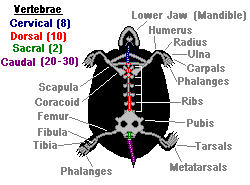This page provides detailed information on the box turtle anatomy. What are specifics of the skeleton of a box turtle, how to tell their sex and information about their organs.
Box turtle skeleton
Box turtles have a hard shell that protects their organs. They can also retract their head and limbs into their shells and close the shell for added protection.

There are two parts to the shell. The top part of the shell, the carapace, is a dome made from the actual back bones and ribs, which have expanded and fused together. The shoulders and pelvic bones are within the ribcage instead of outside it, as is the case with humans and other animals with arms and legs.
The lower part of the shell is called the plastron and connects directly to the carapace. The plastron has a hinge that divides the bottom shell into two halves which can be drawn up to the carapace and close the shell up like a box. Hatchling box turtles do not have a hinge, but develop one after a year or two.

The bony part of the shell is covered with a thin layer of keratin. The keratin layer is divided into segments, called scutes. These scutes and the underlying bones grow incrementally, thus allowing the box turtle to expand and get larger.
Turtles have had over 200,000,000 years to evolve this body type and it’s obviously served them well. Turtles have outlived the dinosaurs and many other prehistoric creatures to become one of the oldest living families in the animal kingdom.
If you are still new to the box turtle world or to the terms used here, you can have a look in our box turtle glossary for an explanation of the most commonly used word in box turtle care.
Sex of a box turtle
Male and female box turtles are sometimes hard to differentiate. Hatchlings and juveniles can be especially hard to identify until they reach sexual maturity at 7-10 years. There are some general characteristics such as size of tail, location of the cloaca or coloration that can be used to sex box turtles, but none have proven to be totally definitive. The only real way to tell if you have a male or female is to watch their behavior until you actually see two mating or one laying eggs.
Males will sometimes strain to evert their reproductive organ while they are in water or wet grass. Experts call this “penis fanning” and they do it for reasons unknown, perhaps for cleaning or cooling. The reproductive organ is shaped like petals on a flower and is dark blue or purplish in color. The first time a turtle owner sees it they may think something is wrong and rush the turtle to the vet. But everything is fine as long as the organ retreats back into the tail vent in a few minutes.
Males will often have red eyes. Their tails are usually longer than the females’ tails and have a thicker base. The opening in the tail, called the cloaca, is further away from the body in males, towards the tip of the tail. The plastron or bottom shell of a male sometimes has a slight or deep depression on it. In the case of Ornate box turtles, a sexually mature male will often have a greenish color on top of the head. A mature Three-toed male may have a dark red head. Female box turtles usually have brown eyes and a shorter tail with the cloaca vent closer to the body. Their hind claws are more slender and straighter than those of the male which can be thick and curving.
Organs of box turtles
There are several differences between turtle internal organs and what we see in mammals. For one thing, box turtles have a three-chambered heart instead of four-chambered heart. Consequently, oxygenated blood from the lungs and venous blood are in the heart chamber at the same time. However, a partial wall in the heart, called an incomplete septum, helps to keep the blood apart. Also, there is a pressure difference between the two types of blood and little mixing occurs.
The location of internal organs are also different than for most other mammals. The lungs, for example, are situated right under the bony shell and above all the other organs. Muscles in the abdomen push the other organs against the lungs and move them in and out like bellows.
The turtle brain has highly developed sight and smell centers, so we know turtles depend on them greatly. In fact, a turtle who has lost its sight or cannot smell due to pneumonia will not eat. These turtles may need force-feeding if their recuperation takes too long. The turtle brain can also withstand longer periods of oxygen depletion than mammal brains.
For this reason, never assume that a box turtle that has been submerged in water for a long period of time is dead. Try to resuscitate it by pumping its back legs in and out while it is lying on its plastron with its head pointed slightly downwards. Use the legs to push against the lungs and expel water. Also, hold the turtle head down and swing your arms in a semi-circle to use centrifugal force to expel water from the lungs.
